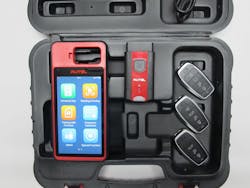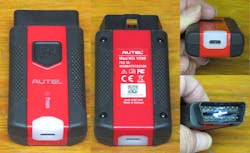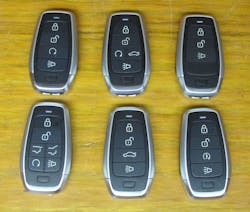The Autel MaxiIM KM100: This Could Change Everything
A zoology instructor was fond of saying, “Things that don’t change are usually dead.” If that’s the case, the Autel MaxiIM KM100 proves that the automotive locksmith trade is definitely alive. This inexpensive little tool well might change our industry forever.
Another thing we all have heard is, “If it sounds too good to be true, it probably is.” That’s what I thought when I first read about the KM100 (Image 1). I just couldn’t believe that a tool from a reputable manufacturer that sold for a reasonable price possibly could do all the things that were claimed. Nevertheless, because of the outstanding capabilities of my Autel MaxiIM IM608 programmer, as soon as the KM100 went on sale, I ordered one and put it to work.
I mentioned the KM100 in a previous article, before I had a chance to work with the tool. At the time, I was under the impression that the KM100 “essentially cloned” the prox fob and speculated that it might be a workaround for the Chrysler “Secure Gateway” mess. I was wrong on both counts.
The KM100 doesn’t clone prox fobs, although it’s capable of cloning keys. The KM100 also doesn’t go around the Chrysler “Secure Gateway” system, but it can be used with most of the bypass cables already on the market. However, Autel doesn’t recommend or support connecting through the green CAN bus connector, also known as the “star connector.” Instead, Autel recommends using their tools with a cable that connects to the Radio Frequency Hub (RFH). Autel offers a Chrysler 12+8 Cable to connect the RFH, which then can be plugged into any tool that has an OBD-II connector, including the KM100.
After I got my KM100, I used it on everything that I could. Within days, I was a believer, and the tool had paid for itself! After a month or two, I also was better aware of its capabilities and weaknesses. Let’s discuss the details.
Two-Piece Weapon
During World War II, Gen. George S. Patton normally carried a pair of highly polished revolvers that had ivory grips. The revolvers became one of his trademarks and always sparked a lot of interest or controversy.
One of the stated reasons why he preferred revolvers was because he considered semi-automatic pistols to be a “Two-Piece Weapon.” He was often heard to say that with an automatic, “If you lose the magazine, it isn’t worth a damn!”
The Autel KM100 is definitely a two-piece weapon. If you lose the Vehicle Communications Interface (VCI) the tool isn’t useless, but you can’t use it to program a vehicle without a way to communicate with that vehicle. The VCI plugs directly into the vehicle’s OBD-II port and communicates with the hand-held base unit of the KM100 via Bluetooth. This means that the base unit and VCI have internal batteries that must be recharged periodically.
The VCI is equipped with a USB-C port for charging and direct communication with the base unit. It also has a flashlight embedded into the OBD-II port to help to locate the port under the dash. (Image 2) I have made it a habit to put all my rechargeable programming tools on charge at the end of the day on Fridays. I also put my jump-box on charge and start any software updates at the same time.
Despite that, I once managed to leave the VCI in a Chrysler 300 that I was programming at a dealership about 40 miles from my office! When I discovered the missing VCI, I frantically called the dealership, and they retrieved it for me. But I had to make an 80-mile round trip the next day because of my oversight. Now, I always carry my KM100 in the case that it came in. That way, when I pack up after programming a vehicle, the case will have an empty spot to remind me to retrieve the VCI.
The base unit also beeps at you to disconnect the VCI when you’re finished programming, but I often turn mine off before it has a chance to beep at me. If you purchase a KM100, you should develop a routine that includes disconnecting and retrieving the VCI every time you use it.
The Base Unit
The base unit of the KM100 (Image 3) is slightly larger than most modern cellphones but still small enough to fit in your pocket. The screen is touch-sensitive, and tempered-glass screen protectors recently have become available for them. I highly recommend a screen protector for any tool that has a touch screen!
The KM100 is essentially a small Android tablet (5.5-inch screen) powered by a built-in rechargeable 4950-mAh lithium-ion battery. The KM100 runs Android 9.0 and has 2GB of RAM and a whopping 64GB of on-board storage. The tool supports Bluetooth and Wi-Fi connections and has an 8-megapixel camera.
But the real beauty of the tool is the OE-level programming software. The tool comes with one year of free software updates, and I’m sure subscription plans for updates will be announced before the tool has been on the market for a year. The touch screen is intuitive and easy to read, even by my 70-year-old eyes.
The IKEY
When you purchase your KM100, it comes with two IKEYs, (Image 4) which are “universal” proximity fobs. As of press time, more than 30 different IKEYs are available, which cover the majority of button patterns that you’ll see in North America. The end of the IKEY comes off and has a slot that will accept Xhorse/KEYDIY key blades for an emergency key. In addition to standard IKEYs, there also are “Premium IKEYs” that look identical to many OEM prox fobs but without the logo. (Image 5)
The generic IKEYs already have gotten me out of a couple of jams. Because I live in a beach town, a significant number of my customers accidentally take the prox fob for a swim. These jobs have to be tackled as quickly as possible, and the IKEYS allow me to help my customers without having to stock thousands of dollars’ worth of fobs that I might never use.
I recently provided service for a woman who had a 2020 Infiniti Q50 and found herself stranded as she was about to check out of the condo that she had been occupying for the past week. Her bags were packed and by the door when her young daughter decided to flush the prox fob for the vehicle down the toilet. The women hadn’t been able to find anyone who could do the job until she called me.
I checked whether the KM100 supported that vehicle and then asked whether the woman’s vehicle had remote start, which it did. I then prepared a four-button Nissan look-alike IKEY before I left the shop and had her back on the road within half an hour of my arrival on the scene. Most of that time was spent decoding the door lock and cutting the emergency key. My cost for doing the job was my fuel to drive to the beach and a nominal fee for the Premium IKEY.
Key Renewal
Autel uses the term “key renewal” for unlocking prox fobs or remotes that previously have been programmed to other vehicles. Autel says the KM100 can renew fobs for 36 different vehicle makes.
The renewal process for Toyota and Lexus fobs and a few others is simple and requires almost no effort on your part. Many other fobs, however, require you to remove the circuit board from the fob and connect to several specific points on the circuit board with an often-soldered-on ribbon cable. That process can be tedious and often requires soldering. I expect some enterprising folks, or possibly Autel, to introduce adapters in the near future that will make the job much easier.
Next month, I’ll outline the process for programming an IKEY.
Steve Young has been a locksmith since 1973 and has trained and taught locksmiths since 1988. He is a frequent contributor to Locksmith Ledger.


